For the entire month of September, I’ll be participating in the SNAP Challenge and attempting to eat on $4.50 per day. Read more here.
For week 4 of the SNAP Challenge, I purchased a rotisserie chicken from which I planned to make a few different meals. Rotisserie chickens are probably one of the most awesome “convenience” items because they are useful for such a wide range of dishes. Once the meat is pulled from the bone it can be use to make just about anything from sandwiches to casseroles, salads, or soups. What’s left over after you pull off all the meat can be used, too! The remaining bone, cartilage, fat, and bits of skin are filled with flavor and nutrients that can be made into the most wonderfully magical chicken broth.
I’ve made homemade chicken broth before using the stove top and it’s unbelievably easy. If you go one step further and use a slow cooker, it’s nearly effortless. All you need is a chicken carcass, a couple vegetables, some herbs, and water. Pop it all into a slow cooker, turn it on, and come back later to find all the work is done for you. Awesome, right?
This time I happened to have some celery, carrots, onions, and parsley on hand because I was going to make chicken noodle soup with them later, but you can make this broth practically cost free by saving your vegetable scraps throughout the month and using them to the flavor the broth instead of the whole vegetables. What do I mean by vegetable scraps? Well, onion and carrot peels, celery leaves, stems from parsley and other herbs, or anything that you’d usually cut off from vegetables and throw away. Cleaning is key, though. You don’t want a sandy broth, so make sure to wash your scraps well (or just wash the whole vegetable well before cutting off the scraps) and don’t save anything that looks rotten or moldy.
The broth is customizable, but onion, carrots, and celery are the magic trio. Garlic is good, too, but you want to go light so that it doesn’t over power the broth. Be careful with other vegetables, as they may change the color or cause odors in the broth (beets, obviously, will turn the broth red and any cruciferous vegetables, like broccoli or cauliflower, will give it a sulfurous smell). For herbs, I like to keep it simple with parsley, bay leaf, and black pepper. You can experiment and customize this to your liking, too (a little thyme or rosemary might be nice).
So, here it is… The incredibly simple step by step process of making chicken broth in a slow cooker:
How To: Slow Cooker Chicken Broth
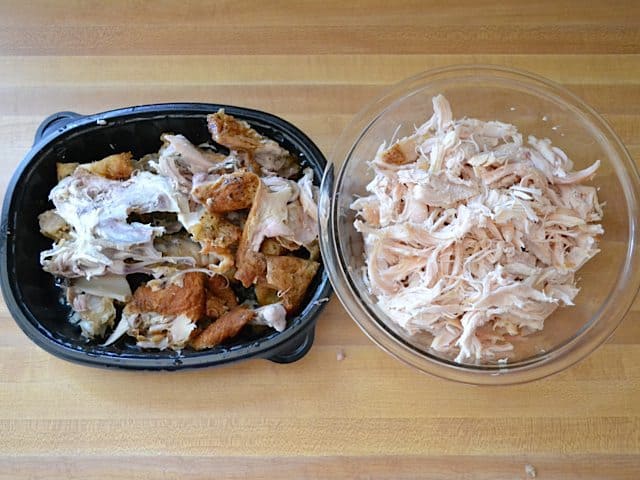
All recipes are rigorously tested in our Nashville Test Kitchen to ensure they are easy, affordable, and delicious.
Step One: Get yourself a chicken carcass. I used the leftover bits of my grocery store rotisserie chicken.
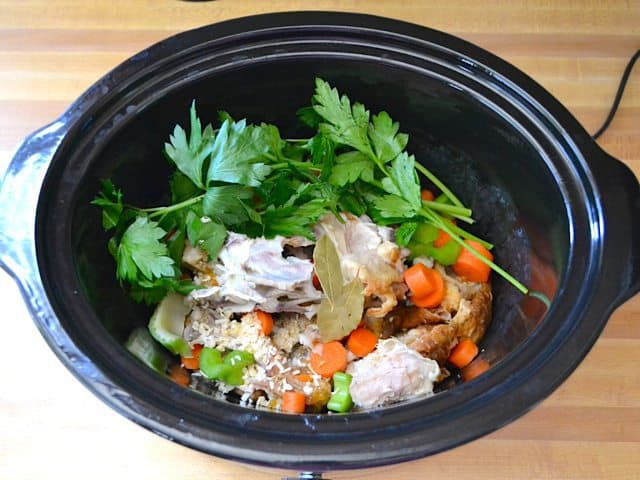
Step Two: Add the chicken carcass, some vegetables, and herbs to a large slow cooker (I think mine is a 5 or 7 quart slow cooker). I used one stalk of celery, two carrots, a handful of parsley, two bay leaves, some freshly cracked pepper, and a sprinkle of dried onion flakes (because I only had one onion left and was saving that for the actual chicken soup).
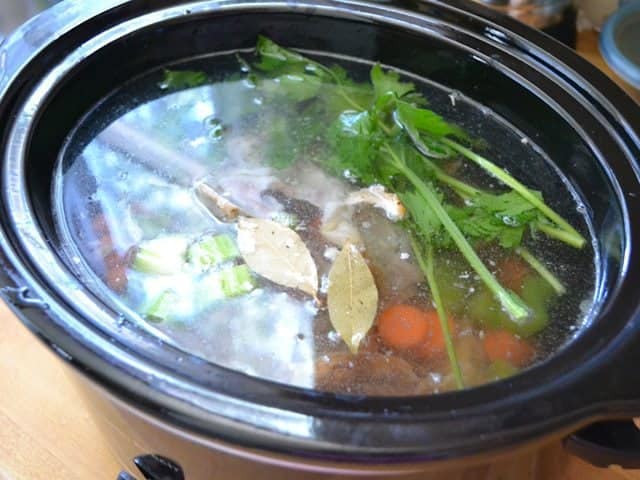
Step Three: Add water. I filled up my slow cooker to the top, which was about 10 cups. There’s no real rule for how much water here, so don’t fret if you can only fit six cups or add up to 12. But, I’d try to add as much water as possible. There’s a lot of flavor in them bones, so don’t let it go to waste.
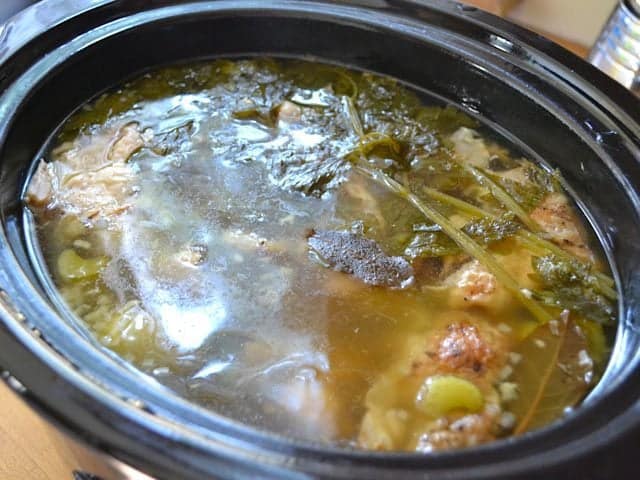
Step Four: Cover the slow cooker, turn it on to high, and let it go for at least six hours. I was short on time, so I had to finish it at 6, but if you let it go longer, the flavor will get deeper. The beauty of the long, slow cooking process is that all of that cartilage breaks down and adds body to the broth. NOM.
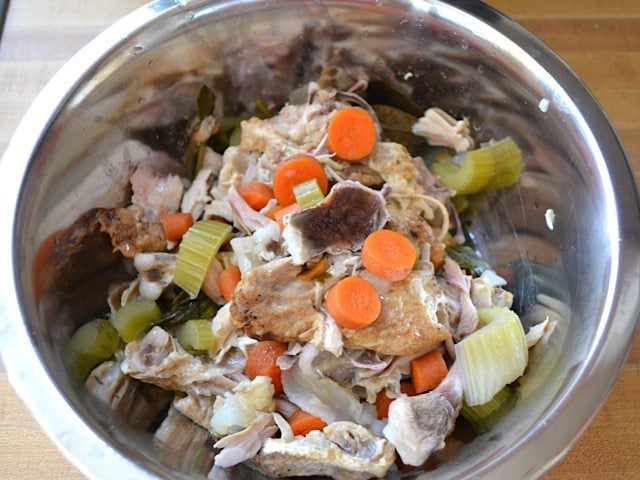
Step Five: Use a slotted spoon to remove the large pieces. Check to see if there is still any meat clinging to the bones, and if there is, you can pick it off and save it. If cooked long enough, the vegetables will have nearly disintegrated into the broth, but because I had to cook mine for a fairly short amount of time they were still whole. I picked those vegetables out and saved them for my chicken soup!
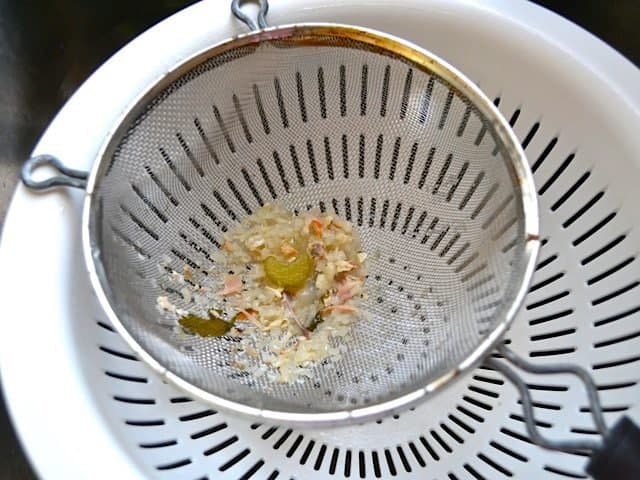
Lastly, you’ll want to strain out the sediment. You can do this with a wire mesh strainer (over a bowl or pot to catch the liquid) or with a colander lined with cheese cloth (again, over a bowl or pot).
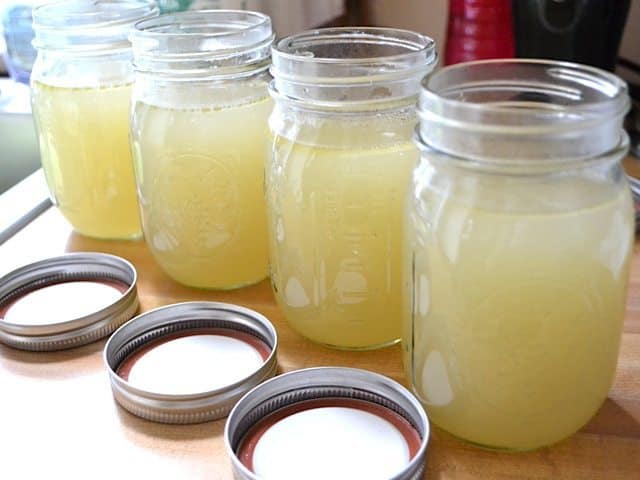
Salt the broth if desired, or you can leave it unsalted and just salt whatever dish you’re using the broth in later. Store the broth in the refrigerator for up to a week or in the freezer for several weeks. If freezing, cool the broth completely in the refrigerator first, then transfer to the freezer. I like to freeze my broth in heavy duty zip top freezer bags laying flat, so they are stackable and don’t take up much space in the freezer. (This is actually a photo from my stove top chicken broth. I was too busy packing up for the move to take photos of the slow cooker broth, but it looked exactly the same!)
I know a lot of you make your own broth at home, so how about sharing your favorite add-ins and tips? Leave a comment below! :D


Awesome recipe for slow cooker chicken broth. I’m actually making it for my dog in which I soak his kibble answer from the refrigerator. He has no teeth so this is a simple way to get the nutrients from the kibble into his tummy. Thank you
Great savings if a person knows how to cut up a whole fryer. It’a a skill worth learning because they are cheaper than parts. I live alone but one chicken provides me with plenty of parts (legs, breasts, wing portions and thighs) for several meals. The wing tips, back, neck, heart and gizzard go into a freezer bag labeled “bony parts”. When it’s full, I throw it all into my slow cooker and make broth. I keep a separate, labeled bag with my veggie scraps for stock. Nothing gets thrown away except for the liver and the cluck! (hello from BR)
Hi there,
How long should I cook a whole chicken I water in my slow cooker if it is on low?
Many thanks?
Hello, I’m sorry I haven’t tried that method so I’m unable to offer advice.
I tend to do 12 hours on low. I find it only gets a darker brown stock
When making Slow Cooked Chicken Broth, can half a Chicken Carcass be used or would that make the Broth too bland?
Yes, that should work great. All the bones and connective tissue will give it plenty of flavor. :)
If you reduce the amount of liquid the flavour should be there
I freeze rotisserie chicken carcasses, skin and drippings and then when I have a few I put them into a zippered mesh laundry bag along with onion, bay leaf, celery tops, whole peppercorns and then into a slow cooker overnight. The laundry bag makes it easy to remove everything when the cooking is done. I then strain thru cheesecloth, cool and refrigerate. Next day I skim off the fat that has risen to the top and add any additional seasoning. A little turmeric gives it a nice color
Hi Beth. My budget requires that I am frugal. I wash and freeze the outer layers of yellow onion which I use in my bone broth instead of buying another onion. I often use celery, carrots, roma tomatoes, and herbs as aromatics. I notice when those food items are just getting ready to transition–but haven’t transitioned–to being not quite right–wash them rough chop them and put them in my freezer.
I love it! Thanks for the tips! :)
Hi Beth. I am making a chicken in the slow cooker now–in the way you posted. Now I am planning ahead, planning to make chicken stock from the carcass. I will be using a real onion, so how much onion do you suggest I use?
Thanks Beth for your blog.
I’ve made broth using one small onion before and it works well. :)
I didn’t even peel or slice the carrot as small as shown in the pictures. Larger chunks of celery and parsnips and a head of garlic sliced in half are also a tasty addition. I’m a huge fan of thyme too.
i put the carcass and veggies on a broiler pan and put them in the oven @ 350 deg roast them until they are bronzed this carmalizes them and adds a real lot more flavor to the broth
karen, ;you put the cooked broth in the fridge overnight then scrap any fat that settled on top off. the fat always settles at the top
Thank you for an amazing blog and recipe.
I’ve always been a bit scared of the amount of fat that is in the broth.
Does anyone know how many calories (roughly) is in it?
It definitely depends on the chicken used. One thing you can do is chill the broth in the refrigerator over night and the fat will float to the surface and solidify, allowing you to just scoop it right off. :)
If using the carcass only and no skin you won’t have much fat. After the broth is chilled the fat will rise to the top and you can skim it off very easily.
Refrigerate the broth and the fat solidifies then skim if off, simple as that but, remember there’s flavor in that fat so you might want to skim only part of it off. Bon Appetito,…..Shalom !
I was wondering if turkey should be done in 2 batches since its bigger?
That’s up to you. If your cooker is big enough, you can do one batch.
I would not recommend saving onion scraps. I would not recommend saving any portion of unused onion for any length of time at all. Even in a sealed container, onions have a way of absorbing all the bacteria around it in the fridge, on the counter, everywhere.
Except, that isn’t true.
http://www.snopes.com/food/tainted/cutonions.asp
Also:
“The fact is that onions are not especially prone to bacterial contamination. In fact, quite the opposite. Onions feature a variety of sulphur compounds that have antibacterial activity.”
http://blogs.mcgill.ca/oss/2012/12/29/is-it-true-that-onions-can-absorb-bacteria/
I just did a slowcooker broth and I did it over several days. At the end of one day I would take out about half the broth and add more water. I ended up with about about 16 cups of broth to freeze. That will do a few soups and it was nice to get that muh since I don’t do whole chickens often.
Like to freeze broth in muffin tins, each muffin round holds about a 1/2 cup of broth. Once frozen pop out the cubes and toss into a freezer bag. It’s an easy way to not only keep broth but to be able to use smaller quantities for gravy, sauces etc…just thought I would share….keep up the great work, I have made both the back bean soup and slow cooker marinara this week and it’s only Wednesday….my freezer will be full and my wallet too….:)
Great tip, thanks!!
That is the best idea I’ve heard in a while ! Thank you for the idea.
Great idea! Thanks so much for sharing it with us.
I boil a chicken once a week but I do it on the stovetop. I pick the meat off and separate it into 2 baggies then save the broth for whatever. Sometimes I use it to make polenta. Yum. I also cook for my chihuahuas. They eat chicken, carrots, garlic, and whole wheat pasta. I save the broth from their food too.
Please be careful about feeding your dogs garlic or onions, it can be very bad for them!
https://www.aspca.org/pet-care/virtual-pet-behaviorist/dog-behavior/foods-are-hazardous-dogs